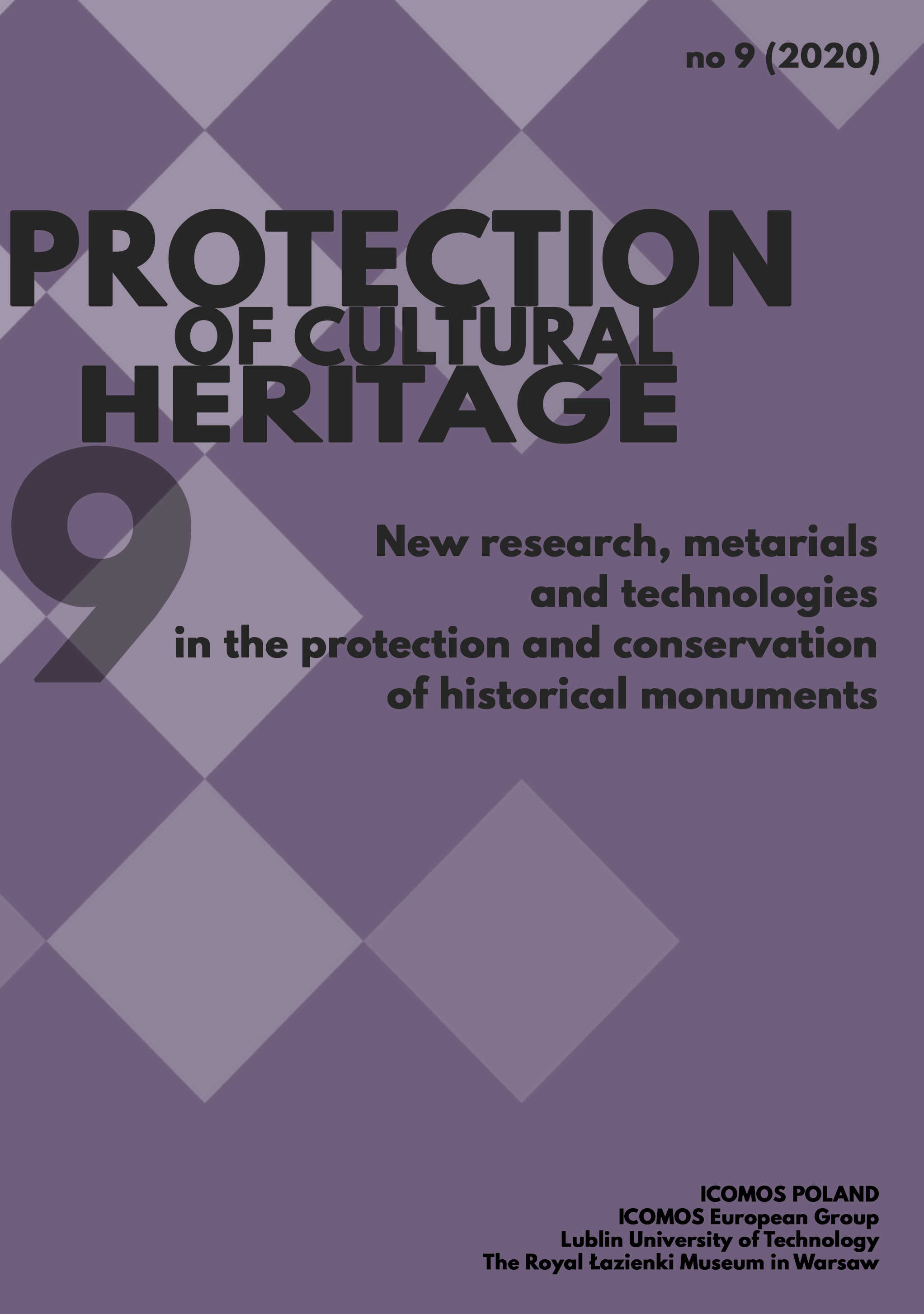Moisture insulation with clay of underground buildings on the example of modern era fortifications and Warsaw Elizeum
Article Sidebar
Open full text
Open full text
Issue No. 9 (2020)
-
Indigenous Cultural Heritage: Developing New Approaches and Best Practices for World Heritage Based on Indigenous Perspectives and Values
Proceedings, Recommendations, and Outcomes of the ICOMOS International Scientific Committee Conference and Forum on Indigenous Cultural Heritage, 2019Diane Archibald1-13 -
Function resulting from the form – adapting the post-war modernist architecture for new functional programs
Błażej Ciarkowski15-28
-
Adaptation of the machine laboratory of the former School of Building Crafts and the Higher School of Machine Construction into the library of the Faculty of Architecture of Wroclaw University of Technology
Elżbieta Grodzka29-41
-
Transformation of the Sea Terminal in Gdynia into the Museum of Emigration
Robert Hirsch43-56
-
Re-creating Indigenous Architectural Knowledge in Arctic Canada and Norway
Nancy Mackin57-72
-
Historical construction wood – extended research methods on the example of old roof trusses
Dominik Mączyński73-81
-
Moisture insulation with clay of underground buildings on the example of modern era fortifications and Warsaw Elizeum
Lech Narębski83-96
-
Eye tracker as a pro-social tool of managing urbanistic and architectural heritage
Marta Alina Rusnak97-115
-
On the necessity and possibilities of providing access for disabled persons to historical public buildings
Barbara Rymsza, Krzysztof Kaperczak, Justyna Kiljan-Walerzak117-127
-
Evolution of the principles of historical monuments conservation – the example of UNESCO World Heritage cities
Boguslaw Szmygin129-140
-
Laser scanning of the wooden church of the Assumption of the Blessed Virgin Mary and St Michael The Archangel in Haczów, Poland
Wojciech Markowski, Anna Wierzejska141-159
Main Article Content
DOI
Authors
Abstract
Keywords:
References
Dybaś B., Fortece Rzeczpospolitej. Studium z dziejów budowy fortyfikacji stałych w państwie polsko-litewskim w XVII wieku, wyd. 2, UMK Toruń 2018.
Gutmejer K. (red.), Elizeum. Podziemny salon księcia. Dla Przyjaciół i Pięknych Pań (praca zbiorowa), wyd.: Miasto Stołeczne Warszawa 2016 r.
Grzeszkiewicz-Kotlewska L., Szczepanik M., Opracowanie wyników badań archeologicznych przy ul. Wały gen. Sikorskiego 13 w Toruniu (2005-2007). Usługi Archeologiczno-Konserwatorskie, Toruń 2007. M-pis, archiwum Woj. Urzędu Ochrony Zabytków w Toruniu, sygn. W/3482.
Hornowski, Wilgotność kazemat (podwalni) i sposoby jej usunięcia. (uwadze korzystających z kazemat-podwalni), Saper i Inżynier Wojskowy, R. 1925, s. 1159-1165. Przedruk INFORT nr 12 (1996), s. 12-14.
Kwiatkowski M., Szymon Bogumił Zug architekt polskiego oświecenia, PWN Warszawa 1971.
Narębski L., Tandecki J. (red.), Atlas Twierdzy Toruń: Zeszyt 6, Pokrzywnicki J., Bramy Twierdzy Toruń, Toruń 2013; Zeszyt 9, Pokrzywnicki J., Początki Pruskiej Twierdzy Toruń, Toruń 2016; Zeszyt 11, Wichrowski M., Narębski L., Pokrzywnicki J., Fort V – Chodkiewicz (Fort III – Scharnhorst), Toruń 2018. Wyd.: Towarzystwo Naukowe w Toruniu, Towarzystwo Przyjaciół Fortyfikacji w Toruniu.
Podruczny G., Przerwa T., Twierdza Srebrna Góra, wyd. Bellona 2010.
Prittwitz M. v., Beitrage zur angewandten Befestigungskunst, erläutert durch Beispiele aus der neuern Preußischen Befestigungsanlagen auf 100 Tafeln, Posen 1836.
Ratke M, Charakterystyka gleb antropogenicznych na wybranych fortyfikacjach w Toruniu. Praca mgr, Zakład Gleboznawstwa Wydz. Biologii i Nauk o Ziemi UMK w Toruniu. M-pis, Toruń 2004.
Rouba B. J., Badania klimatyczne a problematyka konserwatorska, Od badań do konserwacji – Materiały konferencji – Toruń 23-24 10 1998, Wyd. UMK Toruń 2002, s. 193-198.
Stawicki R., Dzieje Szkoły Rycerskiej – Korpusu Kadetów w latach 1765–1794. Biuro Analiz i Dokumentacji Kancelarii Senatu, Warszawa, 2015.
Wagner R. v., Sammlung technischer Bestimmungen für Fortifikations-, Artillerie- und Garnison-Bauten, Berlin 1881.
Article Details
Abstract views: 434
License

This work is licensed under a Creative Commons Attribution-ShareAlike 4.0 International License.






